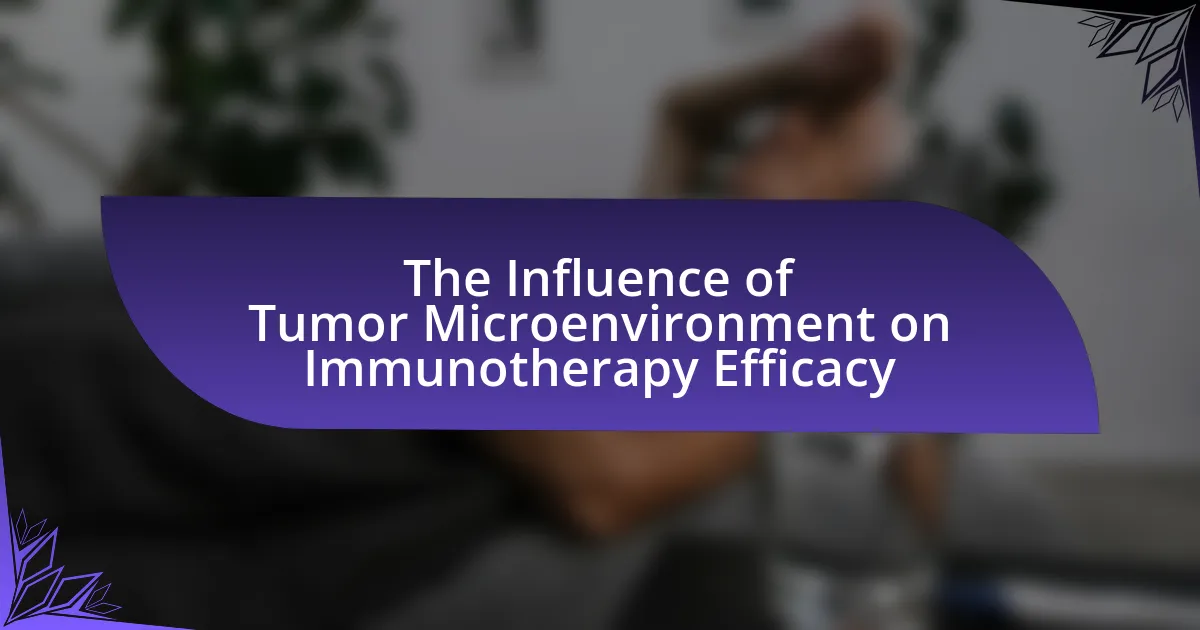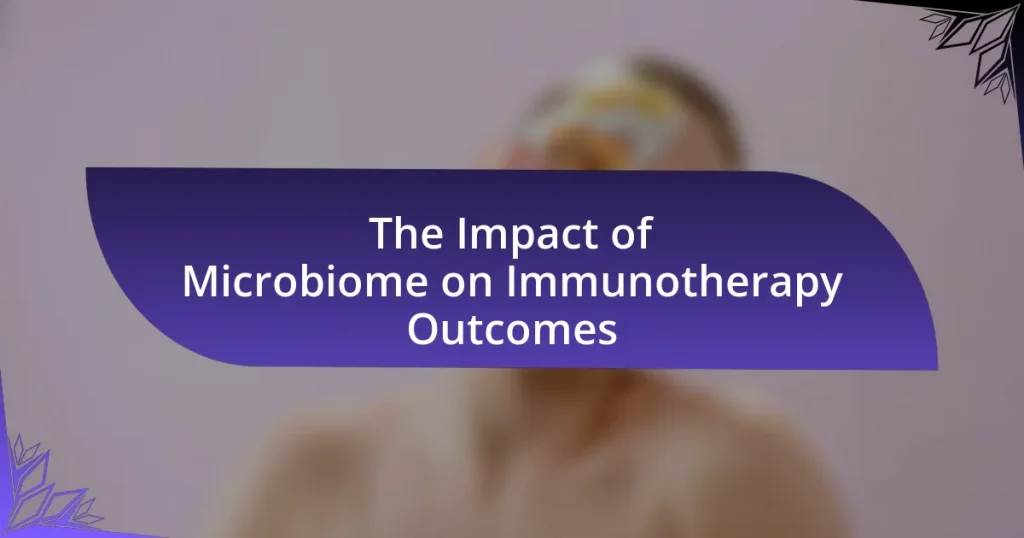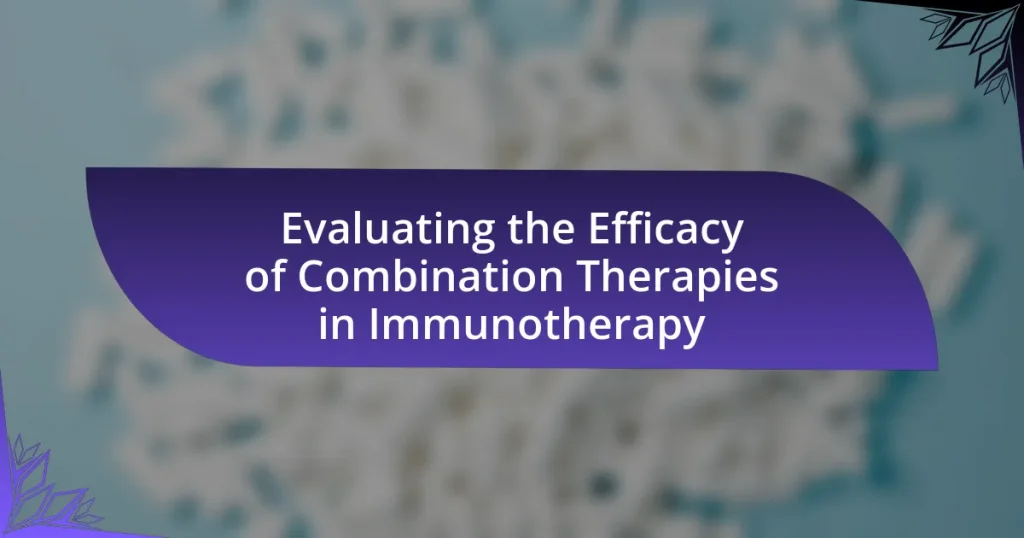The tumor microenvironment (TME) is a complex ecosystem surrounding tumors, comprising various cell types, extracellular matrix components, and signaling molecules that significantly influence immune responses and the efficacy of immunotherapy. This article explores how the TME affects immune cell behavior, highlighting the roles of immunosuppressive cells, hypoxia, and nutrient deprivation in diminishing anti-tumor immunity. It also discusses strategies to target the TME to enhance immunotherapy outcomes, including the use of immune checkpoint inhibitors and combination therapies. Understanding the interactions within the TME is crucial for developing effective immunotherapeutic approaches and improving patient responses to treatment.
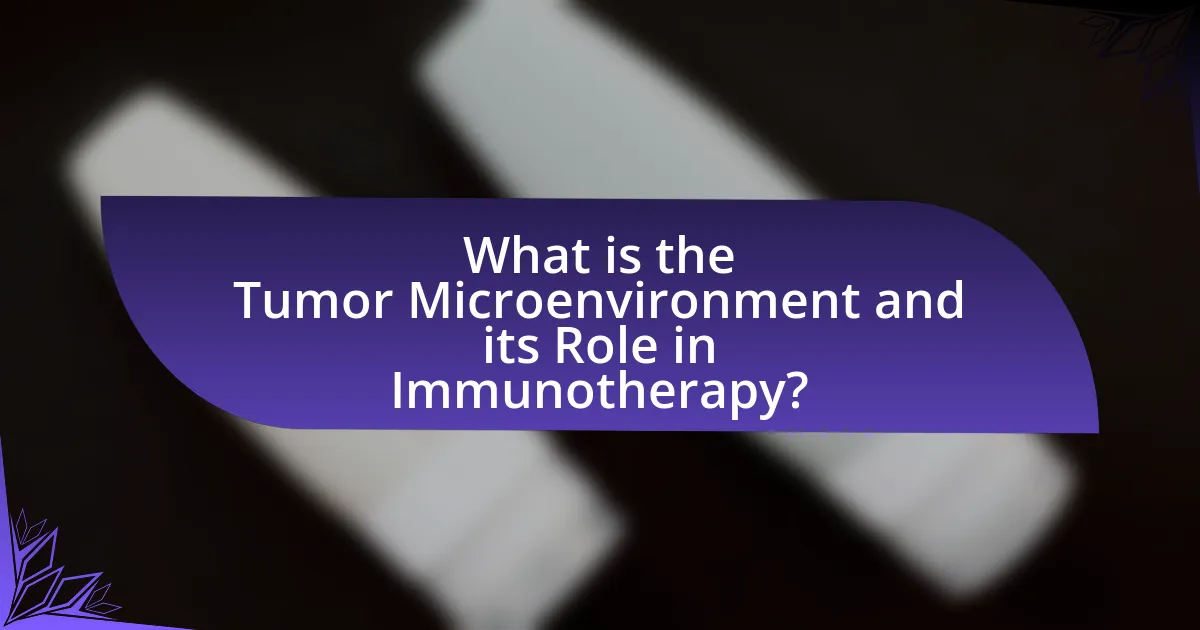
What is the Tumor Microenvironment and its Role in Immunotherapy?
The tumor microenvironment (TME) refers to the complex ecosystem surrounding a tumor, including various cell types, extracellular matrix components, signaling molecules, and blood vessels. The TME plays a critical role in immunotherapy by influencing the immune response against cancer cells. For instance, the presence of immunosuppressive cells, such as regulatory T cells and myeloid-derived suppressor cells, can inhibit the effectiveness of immune checkpoint inhibitors, which are a common form of immunotherapy. Studies have shown that a more inflamed TME, characterized by higher levels of immune cell infiltration, correlates with better responses to immunotherapy, as seen in melanoma and lung cancer patients. Therefore, understanding and targeting the TME is essential for enhancing the efficacy of immunotherapeutic strategies.
How does the Tumor Microenvironment influence immune responses?
The tumor microenvironment significantly influences immune responses by modulating the behavior of immune cells and altering their effectiveness against tumors. This environment is characterized by various factors, including hypoxia, nutrient deprivation, and the presence of immunosuppressive cells such as regulatory T cells and myeloid-derived suppressor cells. These factors can inhibit the activation and proliferation of effector T cells, leading to a reduced anti-tumor immune response. For instance, studies have shown that the presence of transforming growth factor-beta (TGF-β) in the tumor microenvironment can promote immune evasion by inducing the differentiation of naive T cells into regulatory T cells, which further suppresses immune activity. Additionally, the extracellular matrix components can physically hinder immune cell infiltration into the tumor, further diminishing the immune response.
What cellular components are present in the Tumor Microenvironment?
The cellular components present in the Tumor Microenvironment include cancer cells, immune cells, fibroblasts, endothelial cells, and extracellular matrix components. Cancer cells are the primary constituents, driving tumor growth and progression. Immune cells, such as T cells, macrophages, and dendritic cells, play critical roles in the immune response and can either promote or inhibit tumor development. Fibroblasts contribute to the structural framework and can influence tumor behavior through signaling pathways. Endothelial cells form blood vessels that supply nutrients to the tumor, while extracellular matrix components provide support and facilitate cell communication. These components interact dynamically, affecting tumor behavior and influencing the efficacy of immunotherapy treatments.
How do these components interact with immune cells?
Tumor microenvironment components, such as cytokines, extracellular matrix proteins, and immune suppressive cells, interact with immune cells by modulating their activation, proliferation, and function. For instance, cytokines like IL-10 and TGF-beta can inhibit T cell activation and promote regulatory T cell differentiation, leading to immune suppression. Additionally, extracellular matrix proteins can influence immune cell migration and retention within the tumor site, affecting their ability to mount an effective anti-tumor response. Studies have shown that the presence of myeloid-derived suppressor cells (MDSCs) in the tumor microenvironment further impairs T cell function, thereby reducing the efficacy of immunotherapy.
Why is understanding the Tumor Microenvironment crucial for immunotherapy?
Understanding the Tumor Microenvironment is crucial for immunotherapy because it directly influences the effectiveness of immune responses against tumors. The Tumor Microenvironment consists of various cells, signaling molecules, and extracellular matrix components that can either promote or inhibit immune activity. For instance, immunosuppressive cells such as regulatory T cells and myeloid-derived suppressor cells can hinder the activation of cytotoxic T cells, reducing the efficacy of immunotherapeutic agents. Studies have shown that tumors with a more favorable microenvironment, characterized by a higher presence of effector T cells and lower levels of immunosuppressive factors, respond better to immunotherapy. Therefore, a comprehensive understanding of the Tumor Microenvironment allows for the development of strategies to enhance immunotherapy outcomes by targeting these specific components.
What challenges does the Tumor Microenvironment pose to immunotherapy efficacy?
The Tumor Microenvironment (TME) poses significant challenges to immunotherapy efficacy by creating a suppressive environment that hinders immune responses. The TME is characterized by the presence of immunosuppressive cells, such as regulatory T cells and myeloid-derived suppressor cells, which inhibit the activation and function of effector T cells. Additionally, the TME often exhibits a dense extracellular matrix and hypoxic conditions, which can physically obstruct immune cell infiltration and limit their access to tumor cells. Studies have shown that these factors contribute to the failure of various immunotherapies, including checkpoint inhibitors, by preventing effective immune surveillance and response against tumors. For instance, research published in “Nature Reviews Cancer” highlights that the TME can modulate the expression of immune checkpoint molecules, further complicating treatment outcomes.
How can targeting the Tumor Microenvironment enhance treatment outcomes?
Targeting the Tumor Microenvironment (TME) can enhance treatment outcomes by modifying the immunosuppressive conditions that often hinder effective anti-tumor responses. The TME is composed of various cell types, extracellular matrix components, and signaling molecules that can promote tumor growth and protect cancer cells from immune attack. By disrupting these supportive interactions, therapies can improve immune cell infiltration and activation, leading to more robust anti-tumor immunity. For instance, studies have shown that targeting immune checkpoints within the TME can significantly increase the efficacy of immunotherapies, as evidenced by clinical trials demonstrating improved survival rates in patients receiving combination therapies that address both tumor cells and their microenvironment.

What are the Mechanisms by which the Tumor Microenvironment Affects Immunotherapy Efficacy?
The tumor microenvironment affects immunotherapy efficacy through several mechanisms, including immune cell infiltration, cytokine production, and metabolic competition. Immune cell infiltration can either enhance or inhibit the effectiveness of immunotherapy, as the presence of immune suppressive cells like regulatory T cells and myeloid-derived suppressor cells can limit anti-tumor responses. Additionally, the tumor microenvironment often produces cytokines that can create an immunosuppressive milieu, further diminishing the efficacy of immunotherapeutic agents. Metabolic competition for nutrients and oxygen between tumor cells and immune cells can also hinder the activation and function of immune cells, thereby reducing the overall effectiveness of immunotherapy. These mechanisms collectively illustrate how the tumor microenvironment can significantly modulate the response to immunotherapy.
How do hypoxia and nutrient deprivation in the Tumor Microenvironment impact immune cell function?
Hypoxia and nutrient deprivation in the tumor microenvironment significantly impair immune cell function. These conditions lead to a reduction in the effectiveness of T cells and natural killer (NK) cells, which are crucial for anti-tumor immunity. Specifically, hypoxia can cause metabolic reprogramming in immune cells, resulting in decreased proliferation, cytokine production, and cytotoxic activity. Additionally, nutrient deprivation, particularly of glucose and amino acids, further exacerbates immune dysfunction by limiting energy production and essential biosynthetic pathways necessary for immune responses. Research has shown that hypoxic conditions can induce the expression of immune checkpoint molecules, such as PD-L1, on tumor cells, which can inhibit T cell activation and promote immune evasion. This interplay between hypoxia, nutrient scarcity, and immune cell function highlights the challenges faced in enhancing immunotherapy efficacy within the tumor microenvironment.
What are the effects of hypoxia on T cell activity?
Hypoxia negatively affects T cell activity by impairing their proliferation, cytokine production, and overall functionality. Under low oxygen conditions, T cells exhibit reduced expression of key activation markers and decreased ability to produce essential cytokines like interferon-gamma. Studies have shown that hypoxic environments can lead to metabolic reprogramming in T cells, shifting them towards a less effective state, which ultimately diminishes their capacity to mount an effective immune response against tumors. For instance, research published in “Nature Reviews Immunology” highlights that hypoxia can induce the expression of immune checkpoint molecules, further inhibiting T cell activation and function.
How does nutrient availability influence immune cell metabolism?
Nutrient availability significantly influences immune cell metabolism by determining the energy sources and metabolic pathways that immune cells utilize for activation and function. When nutrients such as glucose, amino acids, and lipids are abundant, immune cells can engage in aerobic glycolysis and oxidative phosphorylation, leading to enhanced proliferation and effector functions. Conversely, nutrient scarcity can shift immune cell metabolism towards catabolic pathways, impairing their ability to respond effectively to pathogens or tumors. Research indicates that in the tumor microenvironment, nutrient competition and depletion can lead to metabolic reprogramming of immune cells, which may diminish their efficacy in immunotherapy. For instance, a study published in “Nature” by R. M. O’Sullivan et al. (2019) highlights how tumor-derived metabolites can inhibit T cell activation and function, illustrating the critical role of nutrient availability in shaping immune responses.
What role do immune suppressive cells play in the Tumor Microenvironment?
Immune suppressive cells play a critical role in the tumor microenvironment by inhibiting anti-tumor immune responses. These cells, including regulatory T cells, myeloid-derived suppressor cells, and tumor-associated macrophages, create an immunosuppressive milieu that allows tumors to evade immune detection and destruction. For instance, regulatory T cells can secrete immunosuppressive cytokines like IL-10 and TGF-β, which further dampen the activity of effector T cells. Studies have shown that the presence of myeloid-derived suppressor cells correlates with poor prognosis in various cancers, as they can inhibit T cell activation and promote tumor growth. This immunosuppressive environment significantly impacts the efficacy of immunotherapies, as it limits the ability of therapeutic agents to activate the immune system against the tumor.
How do regulatory T cells and myeloid-derived suppressor cells inhibit anti-tumor immunity?
Regulatory T cells and myeloid-derived suppressor cells inhibit anti-tumor immunity by creating an immunosuppressive environment that dampens the activity of effector T cells and other immune components. Regulatory T cells achieve this through the secretion of anti-inflammatory cytokines such as IL-10 and TGF-β, which suppress the activation and proliferation of effector T cells. Myeloid-derived suppressor cells contribute by producing reactive oxygen species and arginase, which inhibit T cell function and promote tumor growth. Studies have shown that the presence of these cells correlates with poor clinical outcomes in cancer patients, highlighting their role in undermining effective anti-tumor responses.
What strategies can be employed to overcome immune suppression in the Tumor Microenvironment?
Strategies to overcome immune suppression in the Tumor Microenvironment include the use of immune checkpoint inhibitors, adoptive cell transfer therapies, and the modulation of the tumor microenvironment through targeted therapies. Immune checkpoint inhibitors, such as anti-PD-1 and anti-CTLA-4 antibodies, have been shown to enhance T-cell activation and restore immune responses against tumors. Adoptive cell transfer therapies, including CAR T-cell therapy, involve engineering T-cells to better recognize and attack tumor cells. Additionally, targeting immunosuppressive cells within the tumor microenvironment, such as regulatory T-cells and myeloid-derived suppressor cells, can improve immune responses. Studies have demonstrated that combining these strategies can lead to improved patient outcomes, as evidenced by clinical trials showing enhanced efficacy of immunotherapies when used in conjunction with these approaches.
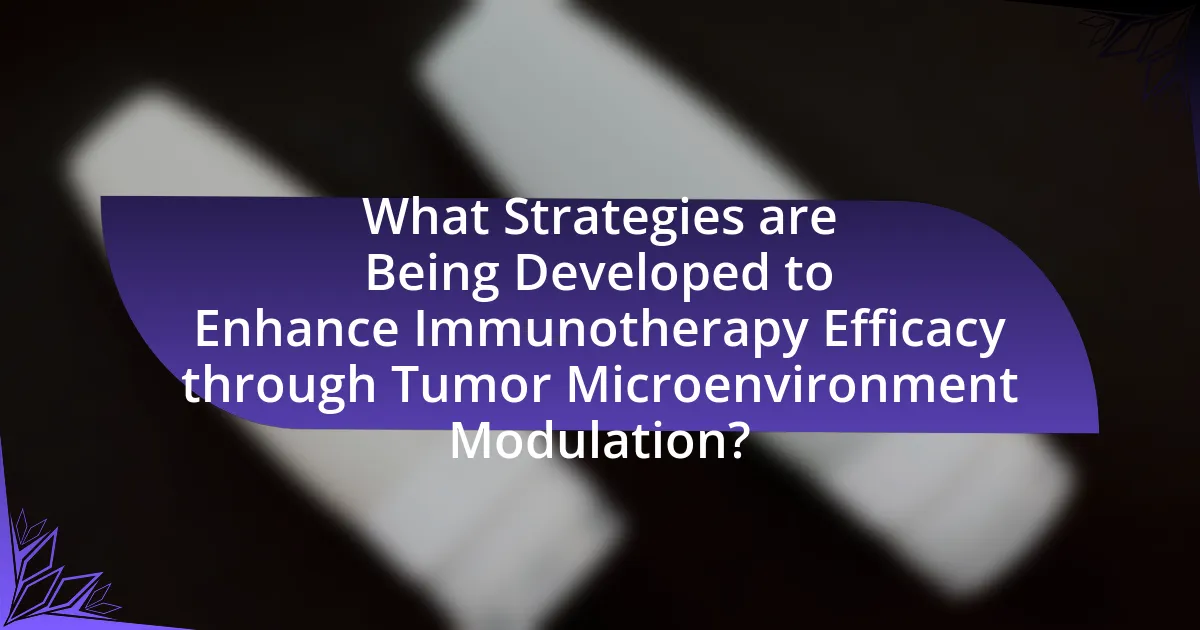
What Strategies are Being Developed to Enhance Immunotherapy Efficacy through Tumor Microenvironment Modulation?
Strategies being developed to enhance immunotherapy efficacy through tumor microenvironment modulation include targeting immune checkpoints, altering metabolic pathways, and utilizing oncolytic viruses. Immune checkpoint inhibitors, such as PD-1 and CTLA-4 blockers, are designed to release the brakes on the immune system, allowing it to better attack tumors. Research has shown that combining these inhibitors with agents that modify the tumor microenvironment can lead to improved outcomes, as evidenced by studies demonstrating enhanced T-cell infiltration and activity in tumors. Additionally, targeting metabolic pathways, such as those involving hypoxia or nutrient deprivation, can reshape the tumor microenvironment to be more conducive to immune responses. For instance, therapies that normalize tumor vasculature have been shown to increase the efficacy of immunotherapies by improving drug delivery and immune cell access. Furthermore, oncolytic viruses can selectively infect and kill cancer cells while simultaneously stimulating an immune response, thereby modifying the tumor microenvironment to favor immune activation. These strategies are supported by ongoing clinical trials and preclinical studies that highlight their potential to improve patient responses to immunotherapy.
How can therapies be designed to modify the Tumor Microenvironment?
Therapies can be designed to modify the Tumor Microenvironment (TME) by targeting specific components such as immune cells, extracellular matrix, and signaling pathways. For instance, immune checkpoint inhibitors can enhance T cell activity within the TME, promoting anti-tumor responses. Additionally, therapies that disrupt the extracellular matrix can improve drug delivery and immune cell infiltration, thereby increasing the efficacy of immunotherapies. Research has shown that modifying the TME can lead to improved outcomes in cancer treatment, as evidenced by studies demonstrating that patients receiving therapies aimed at altering the TME exhibit enhanced immune responses and better survival rates.
What are the potential benefits of using combination therapies?
Combination therapies can enhance treatment efficacy by targeting multiple pathways involved in tumor growth and immune evasion. This approach can lead to improved patient outcomes, as evidenced by studies showing that combining immunotherapy with chemotherapy or targeted therapies can result in higher response rates and prolonged survival in various cancers. For instance, research published in the Journal of Clinical Oncology demonstrated that the combination of immune checkpoint inhibitors with traditional chemotherapy significantly improved overall survival in patients with non-small cell lung cancer. Thus, the potential benefits of combination therapies include increased effectiveness, reduced likelihood of resistance, and improved overall survival rates in cancer treatment.
How do agents targeting the extracellular matrix improve immunotherapy outcomes?
Agents targeting the extracellular matrix enhance immunotherapy outcomes by modifying the tumor microenvironment to facilitate immune cell infiltration and activity. These agents can disrupt the dense extracellular matrix, which often acts as a barrier to immune cell access, thereby improving the efficacy of immune checkpoint inhibitors and other immunotherapeutic strategies. For instance, studies have shown that matrix-degrading enzymes can increase the permeability of tumors, allowing for better penetration of immune cells and increased tumor recognition. This alteration in the tumor microenvironment has been linked to improved responses in various cancer types, demonstrating the critical role of extracellular matrix modulation in enhancing immunotherapy effectiveness.
What are the current clinical approaches to assess the Tumor Microenvironment in patients?
Current clinical approaches to assess the Tumor Microenvironment (TME) in patients include imaging techniques, tissue biopsies, and molecular profiling. Imaging techniques such as MRI and PET scans provide insights into the spatial distribution of tumors and associated immune cells. Tissue biopsies allow for histological examination and characterization of the cellular composition and architecture of the TME. Molecular profiling, including genomic and transcriptomic analyses, enables the identification of specific biomarkers and pathways involved in tumor-immune interactions. These methods collectively enhance the understanding of the TME’s role in influencing immunotherapy efficacy, as evidenced by studies demonstrating that specific immune cell populations and cytokine profiles correlate with treatment responses.
How can biomarkers from the Tumor Microenvironment guide treatment decisions?
Biomarkers from the Tumor Microenvironment can guide treatment decisions by providing insights into tumor behavior, immune response, and potential therapeutic targets. These biomarkers, such as immune cell infiltration, cytokine levels, and extracellular matrix components, help clinicians assess the likelihood of response to immunotherapy. For instance, high levels of PD-L1 expression in the tumor microenvironment are associated with better responses to PD-1/PD-L1 inhibitors, as demonstrated in clinical trials where patients with elevated PD-L1 levels showed improved outcomes. Additionally, the presence of specific immune cell types, like tumor-infiltrating lymphocytes, can indicate a more favorable prognosis and guide the selection of combination therapies. Thus, analyzing these biomarkers enables personalized treatment strategies that enhance the efficacy of immunotherapy.
What role does imaging play in evaluating the Tumor Microenvironment?
Imaging plays a critical role in evaluating the Tumor Microenvironment (TME) by providing insights into its structural and functional characteristics. Techniques such as MRI, PET, and CT scans allow for the visualization of tumor heterogeneity, cellular density, and vascularization within the TME, which are essential for understanding tumor behavior and response to therapies. For instance, imaging can reveal the presence of immune cell infiltration and the distribution of extracellular matrix components, both of which significantly influence immunotherapy efficacy. Studies have shown that imaging biomarkers can predict treatment outcomes, as seen in research published in “Nature Reviews Cancer,” where imaging was linked to the assessment of immune checkpoint blockade responses.
What best practices can be implemented to optimize immunotherapy in relation to the Tumor Microenvironment?
To optimize immunotherapy in relation to the Tumor Microenvironment, best practices include enhancing immune cell infiltration, modulating immune suppressive factors, and utilizing combination therapies. Enhancing immune cell infiltration can be achieved by targeting chemokines and cytokines that promote the recruitment of T cells to the tumor site. Modulating immune suppressive factors, such as regulatory T cells and myeloid-derived suppressor cells, can improve the efficacy of immunotherapy by reducing the barriers to immune activation. Combination therapies, which may include checkpoint inhibitors alongside agents that alter the Tumor Microenvironment, have shown improved outcomes in clinical studies, such as the combination of anti-PD-1 therapy with anti-CTLA-4 therapy, which has been validated in melanoma treatment. These practices are supported by research indicating that a favorable Tumor Microenvironment significantly enhances the effectiveness of immunotherapeutic strategies.
